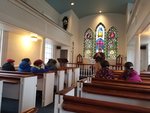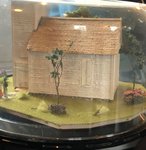As Boy Scouts of America troop members are often leaders in their hometowns, Troops 76, 197 and Girls Troop 572G were invited to a lecture by Islip Town historian George Munkenbeck on Saturday, Dec. …
This item is available in full to subscribers.
We have recently launched a new and improved website. To continue reading, you will need to either log into your subscriber account, or purchase a new subscription.
If you had a login with the previous version of our e-edition, then you already have a login here. You just need to reset your password by clicking here.
If you are a current print subscriber, you can set up a free website account by clicking here.
Otherwise, click here to view your options for subscribing.
Please log in to continue |
|


As Boy Scouts of America troop members are often leaders in their hometowns, Troops 76, 197 and Girls Troop 572G were invited to a lecture by Islip Town historian George Munkenbeck on Saturday, Dec. 5 at St. John’s Episcopal Church in Oakdale, in the hopes of cultivating a sense of historical stewardship in the already community-minded scouts.
St. John’s is the second-oldest church in Suffolk County, having been built in 1765 by the Nicoll Family, who owned a vast tract of land in what is today Islip Township.
A pre-Revolutionary War building, the church is a National Historic Landmark and great measures have been taken to preserve its original character. In its most recent attempt at preservation, funds are being raised to fortify the original floor-to-ceiling windows with blown plane glass (that gives it that unique “wavy” look, especially on a rainy day, as it was on the day of the lecture).
Munkenbeck referred to the church, the only one in Islip Township until the 1840s, as a “mother church,” as most churches in the area can trace their beginnings to the specific building, including Methodists churches and even Catholic St. Lawrence in Sayville.
In 1873, a Brooklyn church donated their medieval French triptych stained-glass windows to St. John’s, which now proudly graces the otherwise simply designed house of worship as the backdrop of the altar.
“The reds and blues in the window can never be replicated,” said Munkenbeck, as many attempts by contemporary artists and scientists in reproducing the equally vibrant and deep tones have failed.
Scouts displayed interest at all turns of discussion of the church’s history and its stewards in the Nicoll family, especially when Munkenbeck brought up the particularly strong, powerful, and invested-in-community-life female members of the large clan.
One scout asked why this history was not covered in school, as she was interested in learning more, especially after hearing that Islip Township had 23 percent of its population fight in the Civil War, the largest percentage in New York State of the smallest area.
A miniature model of the church in its original state was passed around the room, with many scouts admiring the craftsmanship and the simplicity of it.
Munkenbeck regaled the scouts, all Bohemia troops, with the history of Islip Township and its inhabitants as a people who “came here to enjoy themselves and tell others to leave us alone,” bringing in current events like COVID restrictions and government overreach, with them being hedged by early founders of the state.
The scouts were illuminated with the vibrant discussion of the Islip Township founders’ predilection to self-rule.
Comments
No comments on this item Please log in to comment by clicking here